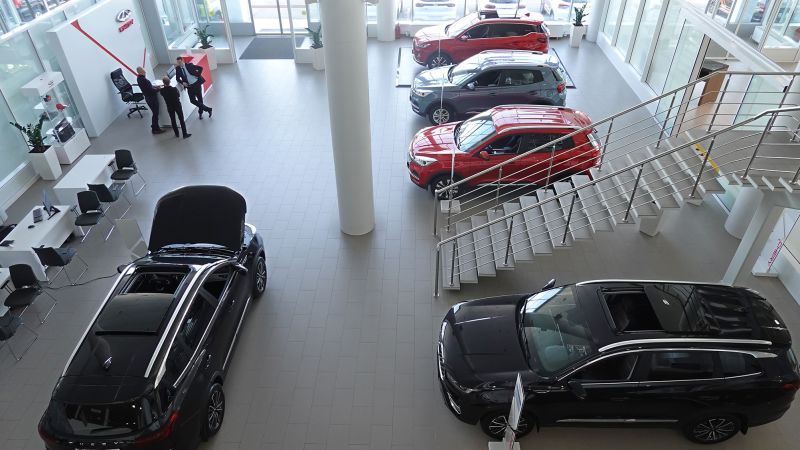
Hong Kong
CNN
—
Over the past year, hundreds of global brands have fled Russia in response to its invasion of Ukraine. That’s forced Russians to find alternatives for everything from smartphones to cars.
The companies benefiting: Chinese competitors. Smartphone giant Xiaomi and automaker Geely are among those that have seen sales surge in recent months, industry data shows.
Where iPhones and Samsung Galaxies were once bestsellers, models from Xiaomi and another Chinese vendor, Realme, now top the sales charts, according to Counterpoint Research.
Chinese manufacturers were already popular in Russia before the war, accounting for approximately 40% of the smartphone market in December 2021. Now, they’ve taken over almost entirely, accounting for 95% of the market a year later, according to Counterpoint data.
Meanwhile, Samsung
(SSNLF) and Apple
(AAPL) — which typically held the number one and two spots, respectively — saw their combined market share drop from 53% to just 3% over the same period as they pulled out of the country.
A similar story is playing out on Russia’s roads. Over the past year, Chinese carmakers Chery and Great Wall Motor have jumped into the top 10 passenger vehicle brands, while Germany’s BMW and Mercedes (MBGAF) have disappeared, according to data from S&P Global Mobility.
Russians bought a record number of Chinese cars last year, according to data provider Autostat. Chinese new car sales in the country rose 7% in 2022, to 121,800 vehicles, even as the market crashed, it said in a report last month.
Lada, the homegrown brand that was already Russia’s most popular carmaker before the war, also saw its market share grow from approximately 22% to 28% in 2022, according to S&P data. (Renault sold its controlling stake in Lada in May.)
These businesses are pretty much the last ones standing.
Like Renault, global automakers pulled out of Russia following its invasion of Ukraine, including Hyundai and Kia, the other large foreign players there.
“It left a huge hole in the market,” said Tu Le, founder of Beijing-based consulting firm Sino Auto Insights. “And the Chinese are glad to fill that hole.”
Xiaomi, Realme and Honor, the budget brand formerly owned by Chinese tech giant Huawei, “reacted quickly to grab the opportunity,” said Jan Stryjak, an associate director of Counterpoint Research. They increased shipments to Russia by 39%, 190% and 24% respectively in the third quarter of 2022, compared to the previous quarter.
Xiaomi has been the main beneficiary, doubling its market share throughout the year. The Beijing-based company is now Russia’s top seller of smartphones, in large part because of its popular Redmi line, an affordable range of devices known for high camera quality.
In response to the corporate exodus, Russia has introduced workarounds to keep some goods on shelves.
Last year, the government authorized what are known as “parallel imports” of smartphones, which allowed goods to be brought in from neighboring countries, such as Kazakhstan.
The practice helped major Russian retailers to continue selling Samsung and Apple phones after direct shipments were suspended, Counterpoint Research analyst Harshit Rastogi wrote in a blog post.
But the measures come with potential problems. Users who bought these phones could have trouble downloading mobile apps that were blocked in Russia, while finding service from official providers was “not guaranteed,” Rastogi noted.
Similarly, people have been buying cars sold into the country via parallel imports, even knowing they won’t have access to warranties, according to Tatiana Hristova, an associate director of automotive research at S&P Global Mobility.
“People are ready to do it because, well, there is no other choice,” she said.
Eager to hang onto premium brands, some Russians have been buying Mercedes and Audis on vacation in Kazakhstan or Uzbekistan in scenes reminiscent of the collapse of the Soviet Union in the 1990s.
“If you wanted to have a car which was not [a Soviet-era] Zhiguli … you just ordered someone who goes to Europe by bus, buys a car for you and brings it for you to Russia,” Hristova said.
Although Chinese brands are reaping the rewards of the Western embargo, the Russian market is shrinking as its economy slumps.
Last year, Russian smartphone sales fell by 33% to 21 million, according to Counterpoint Research. By comparison, Europe’s smartphone market was down 20%.
Russia’s car market fared even worse, declining nearly 60% in 2022 compared to the year before, according to Autostat.
Hristova said that for many Russian consumers, decisions on big-ticket items were “probably on hold right now,” particularly as they brace for potential future waves of military mobilization.
The big question now, according to analysts, is whether the market has changed forever.
If the war in Ukraine ends, Apple and Samsung will likely rebuild operations in the country — and quickly recapture smartphone sales, Stryjak said.
The jury is out on autos, though some firms have already made their interest in returning clear.
In its decision to exit Russia last year, Renault left the door open to come back, with an option to buy back its interest in Lada through 2028, noted Hristova.
Even then, with the return of international brands, Chinese players could retain their foothold, particularly given how long it could take to rebuild supply chains.
Much is likely to depend on how long the war drags on.
“Stating this a bit harshly, but the Russian brands and the Chinese brands are kind of stand-ins for the real players,” said Le at Sino Auto Insights.
“The stand-ins might become the permanent players.”
